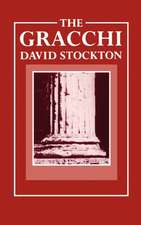Society and Culture in Late Antique Gaul: Revisiting the Sources
Autor Ralph Mathisen, Danuta Shanzeren Limba Engleză Hardback – 17 dec 2001
| Toate formatele și edițiile | Preț | Express |
|---|---|---|
| Paperback (1) | 338.33 lei 6-8 săpt. | |
| Taylor & Francis – 16 mai 2017 | 338.33 lei 6-8 săpt. | |
| Hardback (1) | 768.02 lei 6-8 săpt. | |
| Taylor & Francis – 17 dec 2001 | 768.02 lei 6-8 săpt. |
Preț: 768.02 lei
Preț vechi: 1029.64 lei
-25% Nou
Puncte Express: 1152
Preț estimativ în valută:
147.01€ • 154.44$ • 123.54£
147.01€ • 154.44$ • 123.54£
Carte tipărită la comandă
Livrare economică 12-26 martie
Preluare comenzi: 021 569.72.76
Specificații
ISBN-13: 9780754606246
ISBN-10: 0754606244
Pagini: 342
Dimensiuni: 156 x 234 x 25 mm
Greutate: 0.67 kg
Ediția:1
Editura: Taylor & Francis
Colecția Routledge
Locul publicării:Oxford, United Kingdom
ISBN-10: 0754606244
Pagini: 342
Dimensiuni: 156 x 234 x 25 mm
Greutate: 0.67 kg
Ediția:1
Editura: Taylor & Francis
Colecția Routledge
Locul publicării:Oxford, United Kingdom
Cuprins
Contents: Introduction, Danuta Shanzer, Ralph W. Mathisen; From Roman to Barbarian Gaul: The Visigothic settlement in Aquitania: chronology and archaeology, Andreas Schwarcz; The Visigothic settlement in Aquitania: the Imperial perspective, Michael Kulikowski; Not the Theodosian Code: Euric’s Law and late 5th-century Gaul, Jill Harries; The Gallic Chronicle of 452: a new critical edition with a brief introduction, Richard Burgess; The Gallic Chronicle of 511: a new critical edition with a brief introduction, Richard Burgess; The letters of Ruricius of Limoges and the passage from Roman to Frankish Gaul, Ralph W. Mathisen; Childeric’s grave, Clovis’ succession and the origins of the Merovingian kingdom, Guy Halsall; The quasi-Imperial coinage and fiscal administration of Merovingian Provence, Kevin Uhalde; Religion and Society: Sacred topography: the impact of the Funerary Basilica in late antique Gaul, Bailey Young; Beyond hagiography: epigraphic commemoration and the cult of saints in late antique Trier, Mark A. Handley; Aristocracy and asceticism: the letters of Ennodius and the Gallic and Italian churches, Richard Bartlett; Bishops, letters, fast, food and feast in later Roman Gaul, Danuta Shanzer; Intellectual life: No place for a platonist soul in 5th-century Gaul?: the case of Mamertus Claudianus, Charles Brittain; Avitus of Vienne: the Augustinian poet, Ian N. Wood; The Epistula Rustici ad Eucherium: from the library of Imperial Classics to the library of the Fathers, Mark Vessey; Venantius’ Fortunatus’ elegy on the death of Galswintha (Carm. 6.5), Michael Roberts; Index.
Recenzii
'This is a useful volume that rewards its readers with a synopsis of how scholars interpret historical evidence to illuminate the history of fifth-century Gaul. While they vary greatly among themselves in their approach to the sources, the individual papers all demonstrate deep learning and insight.' Speculum 'Specialists in Late Antiquity will discover much meat in this well-produced collection, but those from other fields will also find this a rewarding glimpse into a cross-section of the continuum of Greco-Roman culture.' Ancient History
Descriere
Late Roman Gaul is often seen either from a classical Roman perspective as an imperial province in decay and under constant threat from barbarian invasion or settlement, or from the medieval one, as the cradle of modern France and Germany. Standard texts and "moments" have emerged and been canonized in the scholarship on the period, be it Gaul aflame in 407 or the much-disputed baptism of Clovis in 496/508. This volume avoids such stereotypes. It brings together state-of-the-art work in archaeology, literary, social, and religious history, philology, philosophy, epigraphy, and numismatics not only to examine under-used and new sources for the period, but also critically to reexamine a few of the old standards. This will provide a fresh view of various more unusual aspects of late Roman Gaul, and also, it is hoped, serve as a model for ways of interpreting the late Roman sources for other areas, times, and contexts.

















